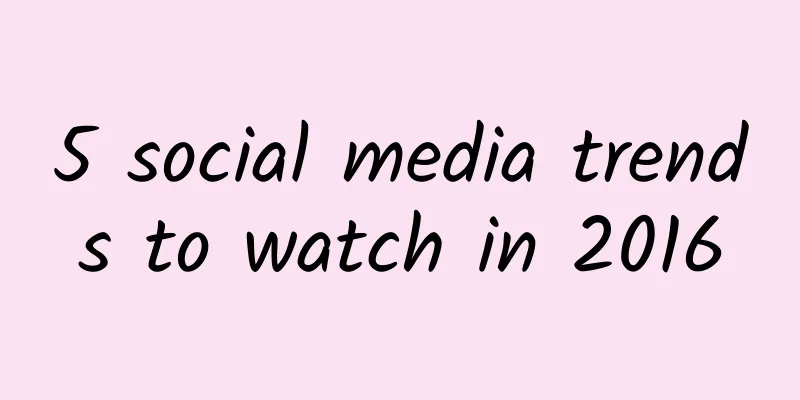5 social media trends to watch in 2016

|
In the past, we could only rely on two things: death and taxes; now we can add one more: social media. Entrepreneurs will then be puzzled and wonder why this is, but they will eventually jump on the bandwagon and try to get involved. Here is a little information for you. There are 5 major trends happening in social media right now that are expected to explode in 2016. I hope it helps. 1. Live streaming becomes mainstream Live streaming is already here, but it’s only going to get better. Twitter Just a few months after its launch, the company’s Periscope service has already gained 15 million registered users, allowing users to instantly share content using their smartphones. Large companies quickly seized on this opportunity. In July 2015, GE ( General Electric) The company's Droneweek (a week of drone live broadcast) event will show the company's factories to the audience, including how jet engines, wind turbines and locomotives are made and tested. The company will conduct a week-long live broadcast with real content. Other types of content that companies can live stream include: meetings, interviews, customer support, product demonstrations, and special offers. For small companies, these live viewers are loyal customers of the company. They want the most detailed information, and live streaming gives them exactly what they need. If you haven't participated in live streaming yet, I hope you will join Periscope in 2016. 2. Online platform content is more open In 2015, Facebook Start to "grab" content from established content creators. In the past, media (publishers) would direct Facebook users to their own websites. Now Facebook's Instant Articles project allows media to publish their content on social media platforms. The content upload speed is 10 times faster than before, more people will see it, and media can also get more advertising revenue. However, users can stay on Facebook, which reduces the brand value of the media itself. Although this is a risk, 350 media outlets have signed on, including the New York Times, BuzzFeed and Huffington Post. More than 100 media outlets upload their content to Facebook every day through Instant Articles. The project expanded from iPhone to Android by the end of 2015. This model forced everyone to compare the advantages of displaying content on Facebook with the advantages of directing users to the web. 3. Smart Uses of Snapchat Of all the social media moves, few have taken as big a risk as Snapchat. You spend time and money creating unique content for your target audience, only to see it disappear once consumed. This is the polar opposite of the “explode fast, burn slow” approach achieved with YouTube videos and blogs. However, major companies such as McDonald's, Acura and Heineken have begun to intervene, wanting to cater to the platform's younger user base and fearing being left behind. The value of content has improved a lot in the last few years, and it’s getting better and better. There are now a lot of great examples of how people can quickly and easily churn out effective ephemeral content. Now, companies no longer need to think hard about good ideas and expect young users to start producing some ephemeral content. 4. Video still beats static content In 2015, news reports emerged that Facebook users posted 75% more videos than the year before. In the U.S., the number was 100%, and Facebook pushed 360% more videos to users' News Feeds than the year before. Between April and November 2015, Facebook's daily video visits increased from 4 billion to 8 billion. Even though the company defines a visit as a three-second watch, that's still a lot of people watching videos, and it looks like Facebook is about to take YouTube's job. These numbers are only going to grow. Facebook has made it clear that it prefers video content over links or images to create any kind of great social media campaign, and this year you might want to turn on your camera and start shooting video. 5. Virtual reality content will debut When Facebook spent $2 billion to acquire Oculus Rift in 2014, social media people were confused. But Facebook's idea is becoming clearer. Just as video is more participatory than pictures, VR content will become the next generation of more participatory content. The New York Times has begun to create VR content that can be viewed using Google's Cardboard, and Paul McCartney once invited VR companies to shoot a VR movie for one of his concerts. It's too early to discuss VR content now, but by the end of this year, we can expect a new type of participatory content and then find ways to use it for ourselves. |
<<: eMarketer: News reading is moving to mobile
>>: Old knowledge and new evidence on "periconceptional folic acid supplementation"
Recommend
If you like to eat snacks such as spicy plum strips, there is actually a serious problem
Among the daily necessities of life, salt is indi...
What should I do if there is a small lump on my breast?
If there is a problem with a woman's breast, ...
How harmful is induced abortion to women?
Induced labor is a common childbirth technique an...
What if it is an ectopic pregnancy?
Anyone who has done their homework seriously know...
After the operation, she felt as if she was lying in water, her whole body was icy cold.
Recently, an anesthesiologist from a large tertia...
What is the origin of Wenchang Chicken? Introduction to Wenchang Chicken
Wenchang Chicken is the most famous traditional d...
How to treat chronic pelvic inflammatory disease, five dietary treatments are recommended
The pelvis is an important and yet very fragile p...
How long after cervical polyp surgery can I have sex
In daily life, we will find that many married wom...
Which is more harmful: staying up late to play with your phone for 10 hours or staying up late to work 10 hours?
Source: Dr. Curious...
What disease is it that causes a small lump to grow on the vulva?
A woman's vagina also needs long-term mainten...
Why do I drink more water and urinate less in late pregnancy?
In the middle and late stages of pregnancy, the f...
How to clean small white shrimps? How to store small white shrimps
White shrimp, also known as spinal tail white shr...
What are some tips for losing weight during breastfeeding?
Women generally have a problem after giving birth...
Is it good to use safflower and salvia miltiorrhiza together? What soup should safflower be paired with?
Safflower is very common in our daily life. Peopl...









